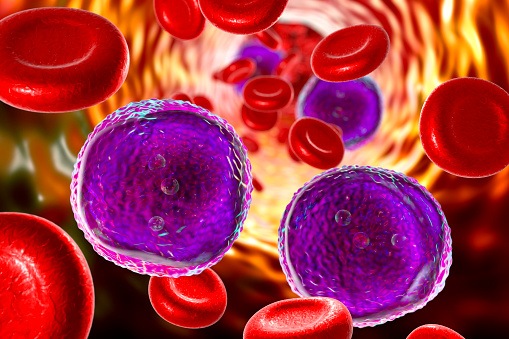What is the first sign of leukemia
Leukemia is a complex and often devastating form of cancer that affects the body’s blood-forming tissues, including the bone marrow and lymphatic system. It is characterized by the rapid production of abnormal white blood cells, which interfere with the body’s ability to produce healthy blood cells. Early detection is crucial for effective treatment, but recognizing the first signs of leukemia can be challenging due to its subtle and often nonspecific symptoms. This article delves into the initial indicators of leukemia, the importance of early diagnosis, and the various types of leukemia that can influence the manifestation of these early signs.

The Nature of Leukemia
Leukemia is broadly categorized into four main types: acute lymphoblastic leukemia (ALL), acute myeloid leukemia (AML), chronic lymphocytic leukemia (CLL), and chronic myeloid leukemia (CML). Each type affects different populations and progresses at varying rates. Acute leukemias (ALL and AML) develop rapidly and require immediate treatment, while chronic leukemias (CLL and CML) progress more slowly and may be monitored before treatment becomes necessary.
Early Signs of Leukemia
- Fatigue and Weakness
One of the earliest and most common signs of leukemia is persistent fatigue and general weakness. Unlike the tiredness that comes from a busy day or lack of sleep, this fatigue is often more profound and unrelenting. It occurs because leukemia cells crowd out healthy blood cells, leading to anemia—a condition characterized by a low red blood cell count. Red blood cells are responsible for carrying oxygen throughout the body, and a deficiency can result in extreme tiredness and lack of energy.
- Frequent Infections
Leukemia affects the production of white blood cells, which are crucial for the immune system to fight off infections. Even though there is an overproduction of white blood cells in leukemia, these cells are often immature and unable to function properly. This results in a weakened immune system, making individuals more susceptible to frequent infections, such as colds, flu, or more severe infections. Persistent or recurrent infections, along with slow recovery times, can be a significant early warning sign.
- Unexplained Weight Loss
Sudden, unexplained weight loss is another early indicator of leukemia. This occurs because the body is using a lot of energy to produce abnormal white blood cells, and the disease itself can alter the body’s metabolism. Additionally, the stress and impact of leukemia on the body can suppress appetite, leading to weight loss without a clear cause.
- Easy Bruising and Bleeding
A hallmark of leukemia is easy bruising and bleeding, which can manifest as frequent nosebleeds, bleeding gums, or tiny red spots on the skin called petechiae. These symptoms arise because leukemia affects the bone marrow’s ability to produce platelets—cells that help the blood clot. Without sufficient platelets, even minor injuries can result in significant bleeding.
- Bone and Joint Pain
Bone and joint pain is particularly associated with acute leukemias, such as ALL and AML. The pain is caused by the overcrowding of abnormal white blood cells in the bone marrow, which increases pressure and leads to discomfort. This pain can range from mild to severe and is often felt in the long bones of the arms and legs.
- Swollen Lymph Nodes
Lymph nodes, small glands that filter lymph—a fluid that circulates through the lymphatic system—can become swollen and tender in leukemia. Swollen lymph nodes are most commonly noticed in the neck, armpit, or groin areas. This swelling occurs because leukemia cells can accumulate in the lymph nodes, causing them to enlarge.
- Fever and Night Sweats
Unexplained fevers and night sweats are also common early signs of leukemia. Fevers can occur without any apparent infection, and night sweats may be so severe that they soak through clothing and bed linens. These symptoms are often related to the body’s response to the leukemia cells and the cytokines (immune system proteins) they release.
Importance of Early Diagnosis
Early detection of leukemia significantly improves the chances of successful treatment and increases the likelihood of achieving remission. However, the nonspecific nature of early symptoms can make diagnosis challenging. Many of the initial signs, such as fatigue, weight loss, and fever, can be attributed to less serious conditions, leading to delays in seeking medical attention.
Healthcare professionals use a combination of methods to diagnose leukemia, including blood tests, bone marrow biopsies, and imaging studies. A complete blood count (CBC) test is often the first step, as it can reveal abnormalities in the number and appearance of blood cells. If leukemia is suspected, a bone marrow biopsy is performed to confirm the diagnosis and determine the specific type of leukemia.
Types of Leukemia and Their Early Signs
- Acute Lymphoblastic Leukemia (ALL)
ALL is most common in children, but it can also occur in adults. Early signs include frequent infections, bone pain, and swollen lymph nodes. Children with ALL may also present with fatigue, paleness, and fever.
- Acute Myeloid Leukemia (AML)
AML primarily affects adults, though it can occur in children. The early symptoms are similar to those of ALL, with fatigue, frequent infections, and easy bruising being prominent. AML can also cause symptoms like shortness of breath due to anemia and bleeding gums.
- Chronic Lymphocytic Leukemia (CLL)
CLL is most commonly diagnosed in older adults and often progresses slowly. Early signs may be less noticeable and include fatigue, swollen lymph nodes, and frequent infections. Some people with CLL may not experience symptoms for years.
- Chronic Myeloid Leukemia (CML)
CML typically affects adults and can be asymptomatic in its early stages. When symptoms do appear, they may include fatigue, weight loss, night sweats, and an enlarged spleen, which can cause a feeling of fullness or discomfort in the abdomen.
When to Seek Medical Attention
It is crucial to consult a healthcare provider if any persistent or unexplained symptoms arise. While these symptoms may be related to less serious conditions, they can also indicate leukemia or other serious illnesses. Early evaluation and diagnosis can lead to prompt treatment, which is vital for better outcomes.
Conclusion
Recognizing the first signs of leukemia can be challenging due to their subtle and nonspecific nature. Persistent fatigue, frequent infections, unexplained weight loss, easy bruising, bone pain, swollen lymph nodes, and fever are among the early indicators that warrant medical attention. Early diagnosis and treatment are crucial for improving the prognosis and achieving remission. Awareness of these symptoms and timely consultation with healthcare professionals can make a significant difference in the management and outcome of leukemia.


